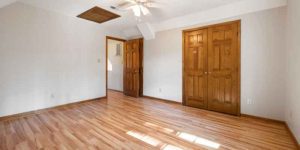Sal wood is one of the types of wood commonly used for door frames. In addition to being heavy and strong, it is also resistant to termites and warping.
Choosing the right wood for a door frame is an essential part of ensuring the longevity and durability of a door. With so many types of wood to choose from, it can be challenging to know which one is right for your project.
We will discuss some common types of wood used for door frames and their characteristics. We will also cover different aspects to consider when choosing the best wood for your door frame, such as durability, cost, and aesthetic appeal.
Types Of Wood For Door Frames
Sal wood is one of the strongest and heaviest types of wood commonly used for making door frames. Other great options include teak wood varieties like Malabar, Balarsha, and Dandeli. Different types of wood are also used for interior and exterior door frames, such as pine, cedar, MDF, HDHMR, and mahogany.
When it comes to door frames, choosing the right type of wood can significantly impact your home’s overall look and feel. However, with so many different types of wood available, it can be challenging to determine which is the best for you. In this post, we’ll explore some of the most popular types of wood for door frames and their unique characteristics.
Mahogany
Mahogany is a popular wood choice for high-end door frames, thanks to its exquisite beauty and durability. It boasts a natural reddish-brown hue that gives it a luxurious and timeless look. Additionally, mahogany is resistant to rot, decay, and insects, making it an excellent choice for outdoor door frames.
Teak
Teak is another premium choice for door frames. It comes in different varieties like Malabar, Balarsha, and Dandeli. What sets teak wood apart from other types of wood is its natural oil content, which makes it highly water-resistant, durable, and resistant to decay and rot. Teak wood also boasts a distinct golden-brown color that darkens over time, giving it an elegant and upscale look that complements any decor.
Sal Wood
Sal wood is a heavyweight hardwood that is popular for its strength and durability. It boasts a light to dark brown hue with prominent darker streaks and edges. Sal wood is exceptionally resistant to insects, termites, and fungi, making it ideal for door frames.
Cedar
Cedar is a popular choice for those seeking a natural and rustic look. This softwood boasts a light brown hue with a prominent wood grain, giving it a unique and charming finish. Cedarwood is naturally resistant to decay, insects, and rot, making it an excellent choice for outdoor door frames.
Pine
Pine is a widely used and affordable wood type that is excellent for interior door frames. It boasts a light yellow to reddish hue that can easily be painted or stained to match your home decor. Pine wood is relatively soft and prone to dents and scratches, but it is still an excellent option for those on a budget.
MDF
Medium-density fiberboard (MDF) is a popular choice for budget-minded homeowners. It boasts a smooth and uniform surface that can be painted or stained to complement any decor. MDF door frames are an excellent alternative to solid wood doors as they are more affordable and hold up well against wear and tear.
In conclusion, choosing the right type of wood for your door frames is crucial for both aesthetic and functional purposes. Each of these types of wood has its unique advantages and disadvantages, so it’s essential to consider your budget, style preferences, and the frames’ intended location before making a choice.
Factors To Consider Before Choosing A Wood Type
Before choosing a wood type for your door frame, it is essential to consider factors like durability, strength, cost, and aesthetics. Some popular options of wood for door frames are teak, sal wood, pine, cedar, and mahogany. Each type of wood has its own unique characteristics, and it’s crucial to choose one that best fits your requirements.
When it comes to choosing the right wood type for your door frame, several factors come into play, including the cost, location, aesthetic appeal, and durability. Each of these factors is essential in ensuring that you get the best value for your money and have a door frame that is perfect for your home or office. In this section, we’ll discuss each of these factors in greater detail to help you choose the best wood type.
1. Cost:The cost of a door frame is an essential factor to consider when making your selection. Different types of wood come at varying prices, and you want to ensure that you pick one that is within your budget. Some of the commonly used types of wood for door frames include teak, sal wood, pine, and MDF. Teak wood is considered one of the best wooden door frame materials but is also the most expensive. Pine and MDF are budget-friendly options that still offer excellent quality.
2. Location:The location of your door frame is another vital factor to consider when selecting wood type. If the door is going to be exposed to the elements, it is crucial to choose a type of wood that can withstand harsh weather conditions. Cedar wood, for example, is known for its excellent resistance to rot and insects, making it a perfect choice for outdoor door frames.
3. Aesthetic Appeal:The aesthetic appeal of a door frame also matters. The wood type you choose should match the look and feel of your home or office. Teak wood, for example, is known for its appealing grain patterns, while pine wood has a simple and rustic look. It’s essential to balance the cost and aesthetics to ensure that you get the perfect door frame.
4. Durability:Finally, durability is crucial when choosing a wood type. You want a door frame that can withstand everyday wear and tear, as well as potential damage from moisture or insects. Sal wood is known for being sturdy and long-lasting, while teak wood is resistant to decay and rot, making it an excellent choice for humid areas.
In conclusion, there are several factors to consider when choosing the right wood type for your door frame, including cost, location, aesthetic appeal, and durability. By weighing these factors, you’ll be able to select a wood type that is perfect for your needs and preferences.

Making The Best Choice
When choosing a type of wood for a door frame, there are several options to consider. Some of the best wood options include teak, sal wood, pine, cedar, and mahogany. Each wood type has its own unique characteristics that make it suitable for different needs and preferences.
When it comes to choosing the right wood for your door frame, there are a few factors to consider. With so many different types of wood available, making the best choice can be a bit overwhelming. Assessing your needs, matching the wood type to the door design, and considering maintenance needs are all essential in making the decision that is right for you.
Assessing Your Needs
Before you choose the type of wood for your door frame, it is important to assess your needs. Are you looking for a wood that is strong and durable or one that has a unique aesthetic appeal? Do you need a wood that is resistant to damage from moisture or termites? Answering these questions will help you determine which type of wood is right for you.
Matching The Wood Type To The Door Design
Not all wood types are suitable for all door designs. For example, intricate designs may require a wood that is easy to carve, while simple designs may not need any special wood type. Matching the wood type to the door design is important because it ensures the door looks natural and doesn’t seem out of place.
Considering Maintenance Needs
Different wood types have different maintenance needs. Some woods require little maintenance, while others may require frequent sealant applications to protect against the elements. Consider your desired level of involvement in maintaining your door frame. Are you willing to put in the effort required to keep the wood looking new, or do you want a low maintenance option?
In conclusion, assessing your needs, matching the wood type to the door design, and considering maintenance needs are important in making the best choice for your door frame. By taking these factors into account, you can choose a wood that looks great, functions well, and doesn’t require too much maintenance.
Process Of Building A Wood Door Frame
One of the most popular types of wood door frames is made from sal wood, known for being heavy and strong. The process of building a wood door frame typically involves measuring and cutting the wood pieces, assembling and securing them with screws or nails, and adding architrave for decorative purposes.
It’s important to choose the right type of wood for your door frame depending on your budget and desired level of durability.
If you want to build a door frame using wood, there are a few steps you need to follow. Building a wood door frame involves three main steps. These steps are measurement and cutting, joining and assembly, and finishing.
Measurement and cutting
The first step is to measure and cut the wood to the required length. The measurement depends on the size of the door. The wood you choose for a door frame should be strong enough to hold the weight of the door. You must keep in mind the type of wood you are using and its dimensions before you start cutting it. Once you measure and mark the cuts, you can use a saw or a cutter to cut the wood.
Joining and assembly
The next step is joining and assembly. The joining is done using screws, nails, or any other appropriate method. You can use a nail gun if you find it difficult to use nails. The joining and assembly steps for the door should be done with precision so that the door frame is sturdy and holds the door firmly.
Finishing
After joining the frame pieces, the next step is to finish the frame. To finish the frame, you need sandpaper, stain, and paint. Sandpaper is used to smoothen the surface of the wood and stain is used to match the door frame color with the appearance of the house. Once the wood dries, you can paint the frame to protect it from wear and tear.
In conclusion, if you want to build your door frame with wood, you should follow these three steps – measurement and cutting, joining and assembly, and finishing. Ensure that you pick the right type of wood and dimensions of wood before you do the cutting. Join the pieces with precision and finish with a good sanding, staining, and paint job to increase the longevity of your door frame.
Maintaining Your Wood Door Frame
Maintaining your wood door frame is important to ensure its longevity. Depending on the type of wood used for your door frame, such as heavy and strong types like Sal wood, or composite options like MDF, you’ll need to use appropriate cleaning and protection methods to prevent rot, cracks, or warping.
Wooden door frames add an unbeatable aura of elegance to the home, and maintaining them is crucial in preserving their beauty and lifespan. If you have invested in a wood door frame, then you already know that it is susceptible to rot and pest damage. Therefore, make sure to keep it clean, and constantly inspect it for any signs of damage, and learn the best ways of maintenance. Below are some of the most critical maintenance tips for your wood door frame.
Prevention of Rot and Pests
Prevention is always better than cure, and that is also true when it comes to your wood door frame. It’s essential to maintain the paint or coating on the wood to keep it from rotting. Additionally, sealing the wood using a quality sealant will keep bugs and pests away. Furthermore, avoid watering the area around the frame plants, as that creates a conducive environment for pests and rotting.
Regular Cleaning
Cleaning is a crucial part of wood door frame maintenance, and it’s a task that should be done regularly. Make sure to dust or wipe the surface of the frame every week using a dry cloth, and use a damp cloth for deep cleaning. Avoid using chemical cleaners, as these can damage the wood. Another tip is to apply wood polish or wax after cleaning, which keeps the wood’s shine and protects it from the elements.
Repairs and Replacements
Even with excellent maintenance, sometimes damage is inevitable. It is important thus to inspect your door frame regularly for cracks, scratches, or warping, which can be an indication of rotting or pest damage. If you notice any defects, make sure to repair them promptly, as delays can worsen the situation. If the frame is extensively damaged, you may need to replace it entirely to prevent further damage to the wall, foundation, and other parts of your home.
In conclusion, maintaining your wood door frame is a crucial part of ensuring its longevity. By following the tips above, you can keep your frame looking brand new, insect-and-rot free, and complementing your home for years to come.

Frequently Asked Questions For Which Is A Type Of Wood Door Frame
What Is The Best Wood For Door Frame?
The best wood for door frames is teak wood, including Malabar, Balarsha, and Dandeli. Another great option is Sal wood, which is heavy and strong, making it ideal for door and window frames. Pine, cedar, and MDF are commonly used for interior door frames.
Mahogany is the most durable and attractive hardwood for exterior doors.
What Wood Is Commonly Used For Doors?
Commonly used woods for doors include teak, sal wood, pine, cedar, and mahogany. Teak wood options like Malabar, Balarsha, and Dandeli are superior class. Sal wood is considered one of the heaviest and strongest types of wood for windows and door frames.
For exterior doors, mahogany is a popular choice due to its durability and attractive appearance. MDF, a type of wood composite, is a budget-friendly option for door frames.
What Wood Goes Around A Door Frame?
The architrave wood is commonly used around a door frame to cover the gap between the wall and the frame. It is often chosen for decorative purposes. Sal wood, teak wood options like Malabar, Balarsha, and Dandeli are some of the best woods used for door frames due to their durability and strength.
Other commonly used door frame materials include pine, poplar, cedar, MDF, and mahogany.
What Boards Are Used For Door Frames?
The boards commonly used for door frames include pine, poplar, and other wood species. Some of the best wood options for door frames are teak, sal wood, and mahogany. MDF, a wood composite, is also a budget-friendly option for door frames.
Additionally, architrave, a decorative piece of wood, goes around the door frame to cover the gap between the wall and the door frame.
Conclusion
To conclude, choosing the right type of wood for your door frame is crucial as it determines its durability and strength. While teak wood, sal wood, and mahogany are some of the popular choices, MDF can be a more budget-friendly alternative.
Remember to consider factors like weather conditions and overall aesthetics while deciding on the wood for your door frame. Investing in a good-quality wood door frame can not only enhance the beauty of your home but also provide superior protection and security.


